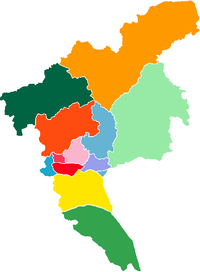Guangzhou Baiyun International Airport
| Guangzhou Baiyun International Airport 广州白云国际机场 | |||||||||||||||||||
|---|---|---|---|---|---|---|---|---|---|---|---|---|---|---|---|---|---|---|---|
 | |||||||||||||||||||
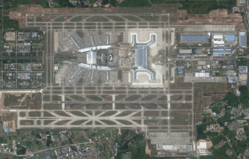 | |||||||||||||||||||
| Summary | |||||||||||||||||||
| Airport type | Public | ||||||||||||||||||
| Owner | Guangzhou Baiyun International Airport Co. Ltd. | ||||||||||||||||||
| Operator | Guangdong Airport Authority | ||||||||||||||||||
| Serves | Guangzhou | ||||||||||||||||||
| Location | Baiyun–Huadu Districts, Guangzhou, Guangdong | ||||||||||||||||||
| Hub for | |||||||||||||||||||
| Focus city for | |||||||||||||||||||
| Elevation AMSL | 15 m / 49 ft | ||||||||||||||||||
| Coordinates | 23°23′33″N 113°17′56″E / 23.39250°N 113.29889°ECoordinates: 23°23′33″N 113°17′56″E / 23.39250°N 113.29889°E | ||||||||||||||||||
| Website | GBIA | ||||||||||||||||||
| Maps | |||||||||||||||||||
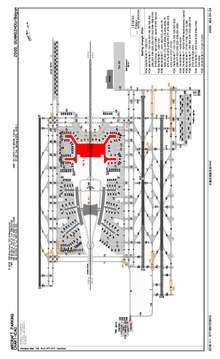 CAAC airport diagram | |||||||||||||||||||
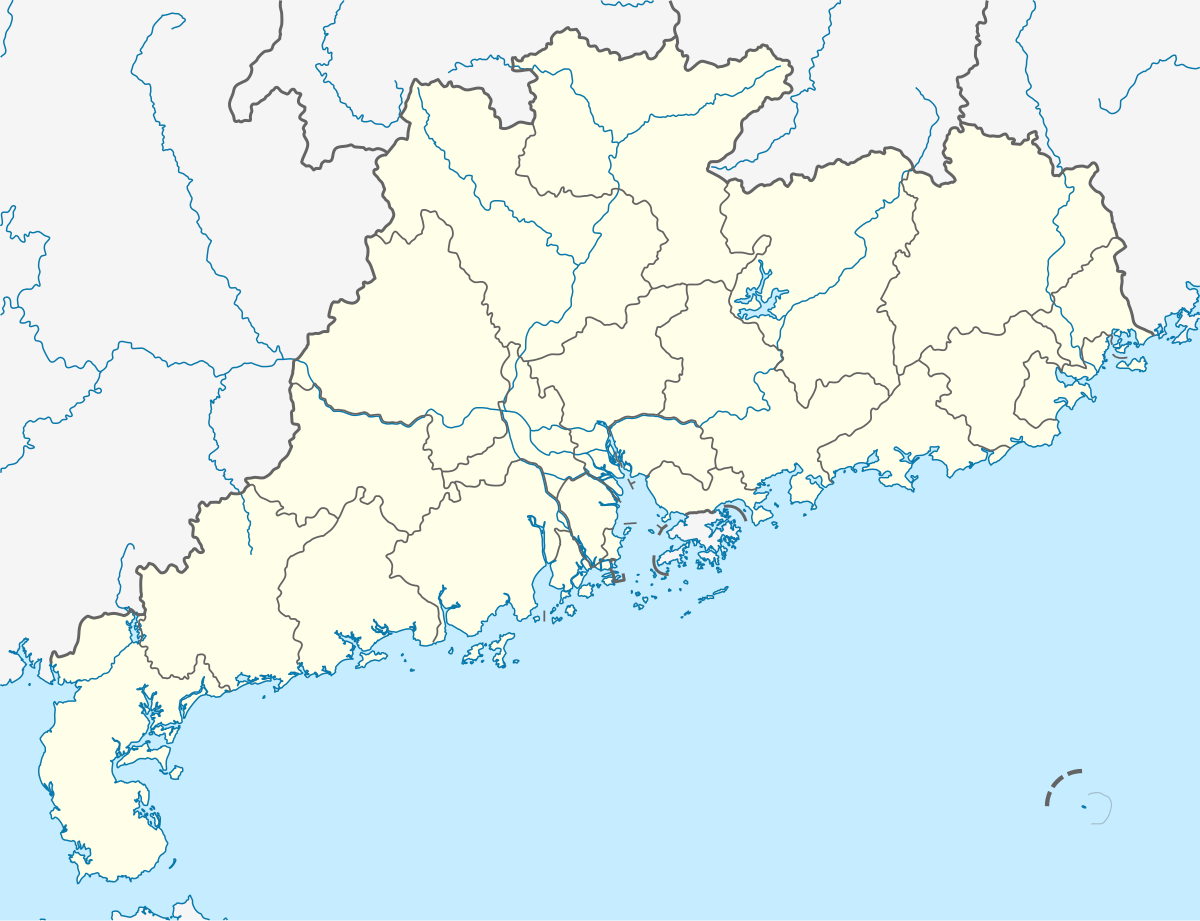 CAN Location of the airport  CAN CAN (China) | |||||||||||||||||||
| Runways | |||||||||||||||||||
| |||||||||||||||||||
| Statistics (2017) | |||||||||||||||||||
| |||||||||||||||||||
| Guangzhou Baiyun International Airport | |||||||||||||
| Simplified Chinese | 广州白云国际机场 | ||||||||||||
|---|---|---|---|---|---|---|---|---|---|---|---|---|---|
| Traditional Chinese | 廣州白雲國際機場 | ||||||||||||
| Cantonese Yale | Gwóngjāu Baahkwàhn Gwokjai Gēichèuhng | ||||||||||||
| |||||||||||||
Guangzhou Baiyun International Airport (IATA: CAN, ICAO: ZGGG) is the major airport of Guangzhou, the capital of Guangdong province, China. Both airport codes were inherited from the former Baiyun Airport, and the IATA code is derived from Guangzhou's historical romanization Canton. Baiyun Airport serves as a hub for China Southern Airlines, FedEx Express, 9 Air, Hainan Airlines and Shenzhen Airlines.
In 2017, Guangzhou Baiyun International Airport was China's third-busiest and world's 13th-busiest airport by passenger traffic, with 65,806,977 passengers handled. As for cargo traffic, the airport was China's third-busiest and the 19th-busiest worldwide. Baiyun airport was also the third-busiest airport in China in terms of aircraft movements.
Overview
1932-2004
The old Baiyun Airport opened in 1932. Due to the expansion of Guangzhou, the airport could not expand to meet passengers needs as buildings surrounded the airport. On August 5, 2004, the new Baiyun airport opened and the old airport was closed.
Since 2004
The new airport is located in Guangzhou's Baiyun District and Huadu District and opened on August 5, 2004 as a replacement for the 72-year-old, identically named former airport, which is now closed. Built at a cost of 19.8 billion yuan, the new airport is 28 kilometres (17 mi) north of downtown Guangzhou and nearly five times larger than its predecessor. "Baiyun" (白云) means "white cloud" in Chinese and refers to the Baiyun Mountain (Baiyunshan), near the former airport even though the mountain is much closer to downtown Guangzhou than it is to the new airport. It is also referred to as "New Baiyun" to distinguish it from the previous airport, but this is not a part of the official name.
Once commissioned, the New Guangzhou Baiyun International Airport overcame most of the problems associated with the old and dilapidated airport including limited space, overcrowding and a lack of room for expansion. Former curfews and restrictions did not apply to the new airport so it could operate 24 hours a day, allowing China Southern Airlines to maximise intercontinental route utilisation with overnight flights. Other airlines also benefit from the removal of previous restrictions.
Data
- Runways: 3—3,800 metres (12,500 ft), 3,800 metres (12,500 ft) and 3,600 metres (11,800 ft)
- Aircraft parking bays: 173 (passenger apron and cargo apron)[2]
- Current passenger capacity: 45 million passengers per year
- Planned passenger capacity in 2020: 80 million passengers per year[3]
- Current cargo capacity: 1 million tonnes
- Planned cargo capacity in 2020: 2.5 million tonnes[3]
- Destinations: 100 (mostly domestic)
- Branch airports: Jieyang, Meizhou, Zhanjiang
Facilities
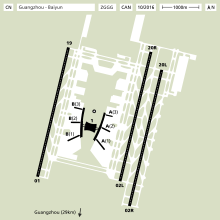
Terminal 1
Terminal 1 has three components, Main Terminal, Area A and Area B. All check-in counters and most retail stores are placed at the Main Terminal. The two concourses controlled by individual security checkpoints, named Area A and Area B, are the boarding gates, security checkpoints, border control, custom & quarantine, baggage reclaim and relative facilities.
Since 24 January 2016, East Pier 1 & 2 are dedicated to serve international flights, domestic flights occupy the rest.
 Check-in counters at Terminal 1
Check-in counters at Terminal 1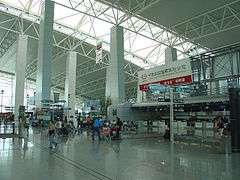 Departure Lobby A at Terminal 1
Departure Lobby A at Terminal 1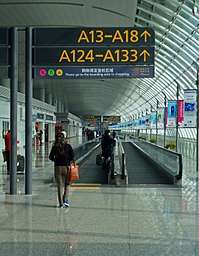 Interior of Terminal 1
Interior of Terminal 1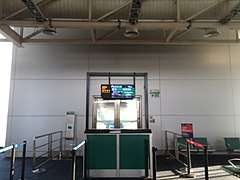 Boarding Gate at Terminal 1
Boarding Gate at Terminal 1 Baggage Claim at Terminal 1
Baggage Claim at Terminal 1
Terminal 2
Terminal 2 opened on April 26, 2018, with an area measuring over 600,000 square metres. When Terminal 2 officially operates, it will be typically home to China Southern Airlines. In addition, most of SkyTeam member airlines will also typically operate in Terminal 2.[4]
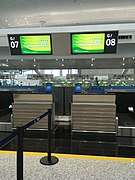 Check-in counters at Terminal 2
Check-in counters at Terminal 2 Self Check-in with baggage Counter at Terminal 2
Self Check-in with baggage Counter at Terminal 2 Departure Lobby at Terminal 2
Departure Lobby at Terminal 2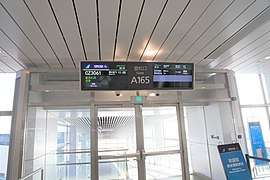 Boarding Gate at Terminal 2
Boarding Gate at Terminal 2 Baggage Claim at Terminal 2
Baggage Claim at Terminal 2
| Airlines | Check-in Counter | |
|---|---|---|
| Domestic | China Southern Airlines, Xiamen Airlines, Sichuan Airlines, Chongqing Airlines, Hebei Airlines | C, D, E, F, G, J |
| International | Japan Airlines, Kenya Airways, Saudia Airlines, Garuda Indonesia | M |
| Korean Air, China Airlines, Vietnam Airlines, Singapore Airlines, Air France, Thai Airways International, Aeroflot Russian Airlines, Sichuan Airlines | N | |
| China Southern Airlines | P, Q |
The new transport centre (GTC) is under construction on the south of terminal 2, passengers will be able to go to Guangzhou downtown by taking metro, rail, bus or taxi there.[5]
FedEx Asia-Pacific hub
.png)
On July 13, 2005, FedEx Express signed a contract with the airport authority to relocate its Asia-Pacific hub from Subic Bay International Airport in the Philippines to Baiyun airport. The new Asia-Pacific hub covers an area of approximate 63 hectares (160 acres), with a total floor space of 82,000 square metres (880,000 sq ft).[6] At the beginning of operation, the hub employed more than 800 people and operated 136 flights a week, providing delivery services among 20 major cities in Asia and linking these cities to more than 220 countries and territories in the world.[7] The Guangzhou hub was, at the time of the opening, the largest FedEx hub outside the United States,[6] but it was later surpassed by the expanded hub at Paris' Charles de Gaulle Airport.[8]
The hub has its own ramp control tower, a first for an international air express cargo company facility in China, which enables FedEx to control aircraft movements on the ground, aircraft parking plans as well as loading and unloading priorities. Included at the hub are a unique package and sorting system with 16 high-speed sorting lines, seven round-out conveyor belts and 90 primary and secondary document-sorting splits. With the new advanced system, up to 24,000 packages can be sorted an hour at the start of operations.[9]
Construction began in 2006 and the hub was originally scheduled to open on December 26, 2008. On November 17, 2008, after several months of testing, FedEx announced that the opening date was delayed to the first half of 2009 when the hub was expected to be fully operational. FedEx claimed that the revised operation date "provided FedEx with the necessary time to fully test all systems and processes, as well as work closely with the Guangzhou authorities to ensure all necessary approvals are in place".[9]
On December 17, 2008, the hub completed its first flight operations test. A FedEx MD-11 aircraft took off from Subic Bay International Airport in the Philippines and landed at Baiyun Airport at 5:50 am. The flight was handled by the new FedEx hub team, using the FedEx ramp control tower and the new 24,000 package per hour sort system. Following a successful operations' process, the flight departed on time for its final destination at Charles de Gaulle Airport in Paris, France. This Asia-Europe flight route operated four times per week during test run. FedEx also announced that the hub would start operation on February 6, 2009.[10]
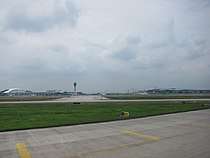
FedEx closed its 13-year-old Asia-Pacific hub at Subic Bay of northern Philippines on February 6, 2009 with the last flight leaving for Taiwan just before dawn, while hub operations have moved to Baiyun Airport.[11] The first flight that arrived at the new FedEx Asia-Pacific hub originated from Indianapolis International Airport. The MD-11 aircraft landed at 11:07 pm at Baiyun International Airport from Charles de Gaulle International Airport in Paris, marking the opening and full operations of the new Asia-Pacific hub.[12]
Runways
Guangzhou Baiyun International Airport now has three runways. The third runway opened on February 5, 2015,[13] which temporarily tackled the long‐standing capacity obstacle. The operation of the third runway expanded Baiyun Airport's capacity, pushing business up.[14] Unfortunately, the third runway can only be used for landing, as its airspace conflicts with Foshan airport[15]. The airport is planning to build two additional runways.[15].
Expansion
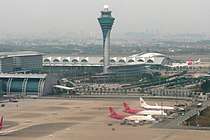
In August 2008, the airport's expansion plan was approved by the National Development and Reform Commission.[16]
It included a third runway, 3,800 metres in length and 60 metres in width, located 400 metres to the east of the existing east runway. The centrepiece of the project is a 531,000-square-metre Terminal 2, equal in size to the current terminal building. Other facilities comprise new indoor and outdoor car parks and a transportation centre with metro and inter-city train services. The total cost of the entire project was estimated to be around ¥18.854 billion. Construction of the third runway began in 2012 and the runway commenced operation in early 2015. The whole project including the new terminal was scheduled to be finished in February 2018, at which time the airport will be able to handle 80 million passengers and 2.5 million tonnes of cargo a year.[3]
According to its master plan, Baiyun Airport will eventually have five runways and a third terminal building, located between the third and fifth runways. When completed, the passenger and cargo handling capacity of the airport will be increased to over 100 million and 5 million tonnes, respectively. A preliminary timetable gives the completion date of 2022.
Airlines and destinations
Passenger

Cargo
Statistics
| Passengers | Aircraft movements | Cargo (tons) | |
|---|---|---|---|
| 2010[47] | 40,975,673 | 329,214 | 1,144,455.7 |
| 2011[48] | 45,040,340 | 349,259 | 1,179,967.7 |
| 2012[49] | 48,309,410 | 373,314 | 1,248,763.8 |
| 2013[50] | 52,450,262 | 394,403 | 1,309,745.5 |
| 2014[51] | 54,780,346 | 412,210 | 1,454,043.8 |
| 2015[52] | 55,201,915 | 409,679 | 1,537,758.9 |
| 2016 | 59,732,147 | 435,231 | 1,652,214.9 |
Ground transportation
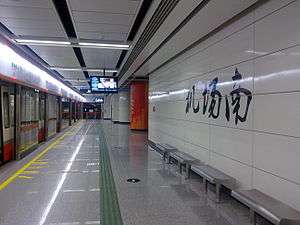
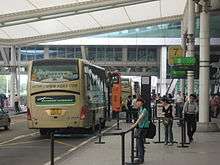
Road
The airport is connected to downtown Guangzhou by the Airport Expressway.
Rail
Guangzhou–Foshan circular intercity railway which is under construction will set the Baiyun Airport Terminal 1 Station, the Baiyun Airport Terminal 2 Station and the Baiyun Airport Terminal 3 Station in the airport. The rail will connect the airport to the Guangzhou South Railway Station and the Guangzhou North Railway Station.
Metro
Baiyun International Airport is served by the Airport South Station and the Airport North Station on Line 3 of Guangzhou Metro.
In the future, Guangzhou Metro Line 18 has a plan to link the airport to the Guangzhou downtown.[53]
Bus
There are 5 Airport Express lines and 6 Airport Non-stop lines to round-trip between airport and downtown. Buses will take passengers to city's major hotels, grand plaza and transportation center, such as Garden Hotel, Guangdong Hotel, CITIC Plaza, Haizhu Square, Tianhe Coach Station, Guangzhou North Station and so on.
To service passengers out of Guangzhou city, the airport also provides intra city bus service. The buses will take up passengers from/to Dongguan, Foshan, Zhongshan, Huizhou, Jiangmen and so on.
See also
References
- ↑ 2016年全国机场生产统计公报 (in Chinese). Civil Aviation Administration of China. 2017-05-03.
- ↑ 在2011年广州地区交通邮电单位协调联席会议上的讲话 (in Chinese). 广州市交通委员会 (Guangzhou City Transport Commission). 2011-01-04. Retrieved 2011-01-23.
- 1 2 3 白云机场高管谈扩建二期项目融资方案待定 (in Chinese). Guangzhou Baiyun International Airport. 2013-05-29. Retrieved 2013-11-06.
- ↑ 白云机场T2航站楼运营配置方案公布 东航等16家公司将进驻. ycwb.com. 2017-05-14. Retrieved 2017-05-14.
- ↑ 白云机场2号航站楼初展风姿 将建成交通“巨无霸”. ycwb.com. 2016-09-01. Retrieved 2016-09-01.
- 1 2 "FedEx Expands Leadership in Asia Pacific with Plan to Build Region's Largest Air Cargo Hub in Guangzhou, China" (Press release). FedEx. 2005-07-13. Retrieved 2008-09-04.
- ↑ "FedEx Express Guangzhou Hub Fact Sheet" (Press release). FedEx. May 2010. Retrieved 2010-05-19.
- ↑ "The Roissy-Charles de Gaulle (CDG) Hub" (PDF) (Press release). FedEx. February 2010. Retrieved 2011-01-20.
- 1 2 "New FedEx Asia-Pacific Hub Prepares for Opening" (Press release). FedEx. 2008-11-17. Retrieved 2008-11-18.
- ↑ "FedEx Initiates Flight Operations Test at its New Asia Pacific Hub in Baiyun International Airport in Guangzhou" (Press release). FedEx. 2008-12-17. Retrieved 2008-12-19.
- ↑ "FedEx closes hub in Philippines". AFP. 2009-02-06. Retrieved 2009-02-07.
- ↑ "FedEx Express Opens New Asia Pacific Hub in Guangzhou, China" (Press release). FedEx. 2009-02-09. Retrieved 2009-02-19.
- ↑ Guangzhou Airport Set to Open Its 3rd Runway on Feb 5. WCARN.com. 2015-01-10. Retrieved 2015-01-10.
- ↑ Guangzhou Baiyun International Airport:Business Growth Picking up,Airport Capacity Gradually Expanding. 研报&兴业证券. 2016-09-07. Retrieved 2016-09-07.
- 1 2 "Shenzhen plans three new airports". Retrieved 23 December 2016.
- ↑ "Baiyun Airport expansion project receives approval from NDRC". AvBuyer.com.cn. 2008-08-24. Archived from the original on 2009-01-09. Retrieved 2008-08-26.
- ↑ https://www.routesonline.com/news/38/airlineroute/280677/9-air-schedules-international-debut-in-october-2018/
- ↑ "【7月1日起】东航广州-曼谷,约吧!".
- ↑ "承让!东航烟台16个新目的地直飞时刻来了".
- ↑ "中国南航开通巴库-乌鲁木齐-广州航班".
- ↑ "China Southern adds Cairns service from Dec 2017". routesonline. Retrieved 8 July 2017.
- ↑ https://www.routesonline.com/news/38/airlineroute/278574/china-southern-adds-guangzhou-da-nang-service-from-june-2018/
- ↑ 2018, UBM (UK) Ltd. "China Southern adds Guangzhou – Lahore route from Aug 2018".
- ↑ "Direct flights between Guangzhou and Tel Aviv starting August (Hebrew) 2Q17". Walla. Retrieved 26 April 2018.
- ↑ 2018, UBM (UK) Ltd. "JC International adds new Sihanoukville – China service in Aug/Sep 2018".
- ↑ 2018, UBM (UK) Ltd. "Lanmei Airlines continues China expansion in mid-May 2018".
- ↑ "Philippine Airlines plans Kalibo – Guangzhou charters from 2Q17". Routesonline. Retrieved 6 March 2017.
- ↑ "Shenzhen Airlines adds Hanoi from late-Sep 2018". routesonline. Retrieved 11 September 2018.
- ↑ 2018, UBM (UK) Ltd. "Shenzhen Airlines adds Guangzhou – Phuket from June 2018".
- ↑ "Shenzhen Airlines adds Utapao service from Nov 2017". routesonline. Retrieved 8 November 2017.
- ↑ "Sichuan Airlines adds Guangzhou – Krabi from Sep 2017". routesonline. Retrieved 23 August 2017.
- ↑ "Spring Airlines adds Guangzhou – Chiang Mai service from July 2018". routesonline. Retrieved 21 June 2018.
- ↑ "Spring Airlines adjusts planned Guangzhou international routes in Sep 2016". routesonline. Retrieved 1 September 2016.
- ↑ "Spring Airlines Adds New Guangzhou International Routes from Sep 2016". routesonline. Retrieved 8 July 2016.
- ↑ "Thai Lion Air confirms Chiang Mai - Guangzhou July 2017 launch". routesonline. Retrieved 9 June 2017.
- ↑ 2018, UBM (UK) Ltd. "US-Bangla Airlines revises Guangzhou launch to late-April 2018".
- ↑ "貨物事業会社「株式会社ANA Cargo」が始動します|プレスリリース|企業情報|ANA". Retrieved 1 June 2015.
- ↑ "Archived copy". Archived from the original on 2014-01-04. Retrieved 2014-01-04.
- ↑ "China Southern Cargo Adds New Routes in W14". Retrieved 1 June 2015.
- ↑ China Southern begins Guangzhou-Frankfurt freighter service | Air Cargo World News Archived 2013-08-28 at the Wayback Machine.. Aircargoworld.com (2013-07-25). Retrieved on 2013-08-16.
- ↑ http://www.stanstedairport.com/about-us/media-centre/press-releases/china-southern-joins-stansted-s-cargo-network/
- ↑ "New cargo flight to Los Angeles - People's Daily Online". English.peopledaily.com.cn. 2010-07-23. Retrieved 2010-08-09.
- ↑ "China Southern Cargo Adds New European Routes from late-June 2015". Airlineroute.net. 24 June 2015. Retrieved 24 June 2015.
- ↑ DVV Media Group GmbH. "China Southern Airlines adds Vienna to B777-200 Frankfurt freighter". Air Cargo News. Retrieved 1 June 2015.
- ↑ "Qatar Airways Cargo commences operations to three new destinations". Archived from the original on 2015-06-01. Retrieved 1 June 2015.
- ↑ 图片 顺丰快递7月1日新开通"广州——北京航线" 民航新闻 民航资源网. News.carnoc.com. Retrieved on 2013-08-16.
- ↑ "2010年全国机场吞吐量排名". Civil Aviation Administration of China. 15 March 2011. Retrieved 15 March 2011.
- ↑ "2011年全国机场吞吐量排名". Civil Aviation Administration of China. 22 March 2013. Retrieved 22 March 2013.
- ↑ "2012年全国机场吞吐量排名". Civil Aviation Administration of China. 28 March 2013. Retrieved 28 March 2013.
- ↑ "2013年全国机场吞吐量排名". Civil Aviation Administration of China. 24 March 2014. Retrieved 24 March 2014.
- ↑ "2014年全国机场吞吐量排名". Civil Aviation Administration of China. 3 April 2015. Archived from the original on 7 October 2016. Retrieved 3 April 2015.
- ↑ "2015年全国机场吞吐量排名". Civil Aviation Administration of China. 31 March 2016. Retrieved 31 March 2016.
- ↑ "广州地铁18及22号线下月开工 18号线北延至白云机场". Nanfang Daily. 26 Sep 2017. Retrieved 26 Sep 2017.
External links
- Official website
- Airport information for ZGGG at World Aero Data. Data current as of October 2006.

